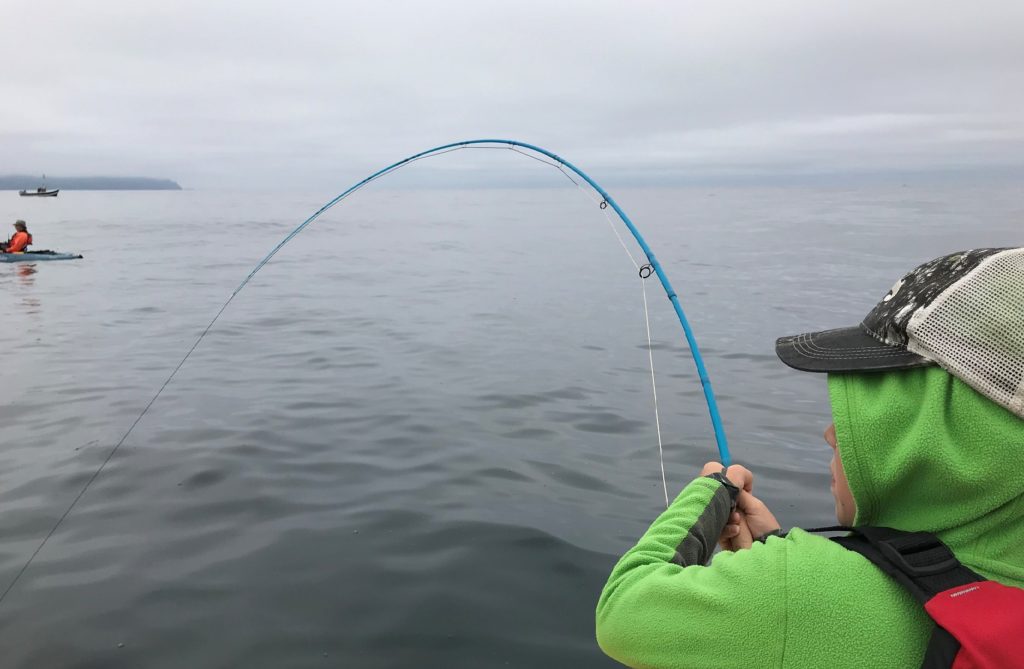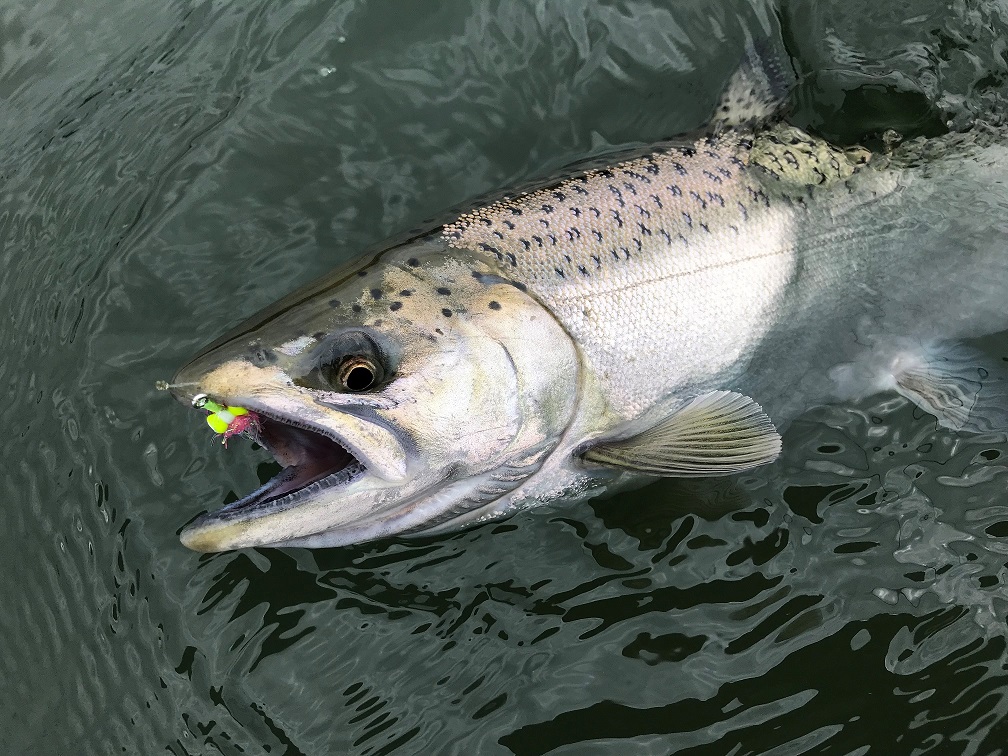I started out to write a review of the Echo Bad Ass Glass fly rod series, including the 8′ and 9′ rods, but quickly decided that I’d need first to dig a little deeper than simply relate my reaction to fishing these fly rods. Here goes….
I find it a little strange that I’m writing about fiberglass fly rods in 2018. Silly, I suppose, but consider the fly fishing world I’ve grown up in since the early 1960s when my dad bought two Wright McGill Eagle Claw fiberglass fly rods at Foster Sporting Goods store on the East Side in Portland, Oregon.
For decades now, we fly fishers have been pushed, pulled and otherwise lured by the quest for rods that are lighter and faster. We wanted to cast farther, with tighter line loops and higher line speed. We wanted fly rods that felt light in hand and wouldn’t wiggle and bounce when we released our forward cast. We wanted rods that were lighter and lighter and lighter, faster and faster, thinner and thinner, less and less wind resistant. In short, we got exactly what we wanted, and what we were taught to want.
Somewhere along the way, I think, the incremental improvements we gained in casting performance we gained with successive generations of graphite rods were coming in such small increments that the typical fly angler was incapable of discerning the difference between “old” and “next gen” graphite fly rods. Sure, we were confident that our fly rods were lighter in hand and capable of blasting out long casts, but these properties came at the expense of fly rod “feel”. At least a few anglers and rod designers began to imagine a return to fly rods that delivered some of the desirable features of glass rods.
I doubt that anyone wanted our fly rods to get heavy again, but a little extra weight might be worthwhile if accompanied by better “feel” when casting, deeper flex when fighting fish, and greater resistance to the impact of misdirected bead heads traveling at Mach 3.5.
Tim Rajeff was up to the challenge, and anyone who has been following the Echo Fly Fishing movement for the last decade will remember the gradual introduction of fiberglass rods to include six distinct glass rod designs.
- Small Water Glass
- Big Water Glass
- Glass Spey
- Glass Switch
- Bad Ass Glass – Original 9′
- Bad Ass Glass – Quickshot 8′
The very first thing I ought to say is this: Echo Bad Ass Glass fly rods are not your typical freshwater trout, switch or spey rods—these are very powerful saltwater fly rods that generate high line speeds and deliver serious lifting power. Bad Ass Glass rods are engineered to cast in harsh environments and fight strong, hard-pulling fish. Don’t think for even a minute that these modern fiberglass rods represent a simple return to the same materials and taper designs used in the fly rods we fished fifty and sixty years ago.
Glass vs Graphite Fundamentals:
Fiberglass Graphite
Heavier Lighter
Mores stretch ~ 3% Less stretch ~ 1%
Softer Harder
Rod features: Fiberglass Graphite
Overall Weight More Less
Rod flex More Less
Rod “feel” More Less
Recovery Slower Faster
Rod Profile Thicker Thinner
Rod Shaft Walls Thicker Thinner
Wind Resistance More Less
Rod Action Softer Faster
Tippet Protection More Less
When is the 9′ BAG superior?
- If you will be making roll casts or line mending, the longer rod will be an advantage.
- The 9′ BAG is neck-and-neck with the QS 8′ when trolling or mooching flies in the salt.
- Casting in environments where you will have brush or boat gear behind you may call for the longer BAG. Basically, the longer rod allows the caster to elevate the back cast above the obstructions.
- I cast a traditional WF fly line a little farther with the 9′ than with the 8′ (I think).

The 8′ QuickShot BAG will be the best rod choice when:
- You are sight fishing and need to fire a cast very quickly.
- Let’s say that you’re fishing from a boat—you may need to cast very quickly, minimize the number of false casts, and make sure your back cast doesn’t foul another angler or the boat rigging—these conditions all favor the 8′ QuickShot.
- The QuickShot will generate higher (slightly) line speeds and tighter loops.
- Shorter head fly lines will perform better on the QuickShot.
- Driving larger flies into wind will favor the shorter rod, line class by line class.
- Swing weight is a factor. A hundred casts with a 9′ 9wt BAG will take more energy than the same hundred casts with an 8′ 9wt BAG QuickShot rod.

Tips for making the transition from modern graphite to casting the Bad Ass Glass rods.
- Tempo is critical when you’re casting glass rods. Wait for it. Slow down your casting stroke. These rods will not tolerate your impatience.
- The softer action of the glass will favor a longer stroke length; the fiberglass rod bends more than graphite so you need to let your hand drift back behind you a little further before making the forward stroke.
- Avoid the short aggressive forward casting strokes you probably learned with a fast action graphite fly rod. Instead, apply power later in your forward stroke.
- Apply power, but not too much power. Another way to phrase this point is to say that applying too much power too quickly runs the risk of collapsing the rod. Apply power on back and forward strokes smoothly with a gradual transition and save the most power for the last portion of the stroke.
- I make the same 50-80′ casts with my BAG rods that I make with fast action fly rods, fishing fly lines that feature both modest and aggressive weight forward tapers. I’ve never been a 100′ hero caster, and you shouldn’t be fishing a BAG if you are expecting to make super long casts.
- Back to making 50-foot versus 80-foot casts, I can look anyone in the eye with a straight face and claim 70′, but the 80′ might need to be wind aided. The point here is that the timing of my 50-foot cast is a tad faster than the timing of my 70′ cast. I need to slow down a little more to make the longer cast.

Cosmetics of the Bad Ass Glass rods.
- Beautiful, unique, translucent blue. Wow!
- Saltwater resistant hardware
- Custom BAG Rod sock
- Cool blue fiberglass rod tube
- High quality guides
- High quality cork handles appropriate to line class
- Fighting butt
How do I feel about the BAG fiberglass fly rods after fishing them for roughly a year?
I’ve been so pleased with the performance of these fiberglass rods that I now consider them a permanent resident of my cabin at Pacific City.
- I rigged the 12wt 9′ BAG to fish Albacore offshore when we ventured 50 miles offshore last week. No tuna this time, but this rod was tons of fun to flight tuna on in 2017.
- I loved how the 9′ 9wt BAG felt when I fished lingcod, These beasts pull hard and bend the rod into the cork every time. I caught far more black rockfish than lingcod, and the 9wt rod was far more than needed for the feisty bass. I’ll be switching over to a 6 or 7 wt, 8′ QuickShot for my future adventures with the black rockfish and coho salmon in the soon to open ocean season.
- The 8wt BAG rods were very nice additions to my estuary chinook fly rods. By far, I preferred to fish the 8wt rods in the estuary rather than fishing the 9wt.
- This is a fishery that requires perhaps a thousand casts between grabs—I choose the lighter swing weight of the #8 BAG rods over the #9 rods.
- The 8′ QS and 9′ BAG rods are perfectly suited to fighting Chinook in the 6-24 pound class—these salmon put an impressive bend in the rod, but the rod was clearly up to the task.
- I was able to cast all of my usually estuary fly lines on both the 8′ and 9′ BAG rods, but found the 9′ rod better for casting lighter traditional taper weight forward fly lines.

Conclusion?
I’ll likely be throwing one or more of Tim Rajeff’s BAD ASS GLASS fly rods in my boat when I push off at the boat ramp or beach. Thanks Tim, another winner!

~ Jay Nicholas is an Echo and Airflo Pro Team member and friend of all of us at Rajeff Sports. He is the author of several fly fishing and tying books, his latest work ‘Modern Steelhead Flies’, features over 400 fly patterns from 66 contributing tiers, and over 1000 beautiful photos. Jay is a regular contributor to the Oregon Fly Fishing blog run by Caddis Fly Shop in Eugene, OR.

Recent Comments